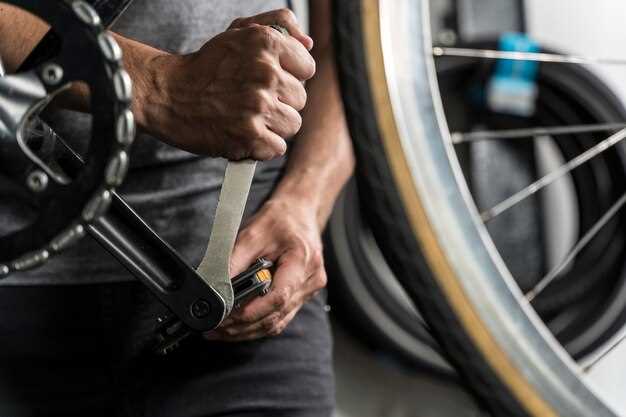
Understanding the importance of chain tension is crucial for any cyclist looking to enhance their riding experience. A properly adjusted chain not only improves efficiency but also contributes to the overall longevity of your bike’s components. When the tension is too loose or too tight, it can lead to a range of issues, from poor gear shifting to increased wear on the drivetrain.
During your bike maintenance routine, evaluating the adjustment of the chain tension should be a priority. The chain connects the pedals to the rear wheel, translating your pedaling power into motion. An inadequately adjusted chain can cause slippage or even derailment, undermining your safety and comfort while riding.
In this article, we will explore the best practices for adjusting chain tension, ensuring your bike operates smoothly and efficiently. Whether you are a seasoned cyclist or a newcomer to the sport, mastering this skill is essential in maintaining an optimal cycling experience. Let’s dive into the steps required to achieve the perfect chain tension.
Understanding Chain Tension and Its Impact on Performance

Chain tension is a critical aspect of bicycle maintenance that directly influences performance and overall cycling experience. Proper tension ensures that the chain remains engaged with the teeth of the rear wheel’s sprockets, allowing for efficient power transfer from the pedals to the drive system.
Inadequate chain tension can lead to several issues, including poor shifting, skipped gears, and increased wear on both the chain and the rear cassette. When the chain is too loose, it may slip off the sprockets during acceleration or when climbing, resulting in a loss of energy and momentum. Conversely, a chain that is excessively tight can cause unnecessary friction, leading to increased resistance and potential damage to the drivetrain components.
Maintaining the correct chain tension allows cyclists to experience smoother gear transitions and enhanced power delivery. By regularly checking and adjusting the tension, cyclists can prevent wear and tear, ensuring a longer lifespan for both the chain and the rear wheel components. Factors such as a rider’s weight, riding style, and terrain can also influence the ideal chain tension, making it essential for each cyclist to find their optimal setup.
In summary, understanding and adjusting chain tension is vital for maximizing performance. By ensuring that the chain is properly tensioned, cyclists can enjoy a more efficient ride, lower maintenance costs, and improved overall riding satisfaction.
Step-by-Step Guide to Adjusting Rear Wheel Chain Tension
Maintaining the correct chain tension is crucial for an efficient biking experience. An improperly adjusted chain can lead to poor performance and increased wear on your components. Follow these steps to ensure your rear wheel chain is tensioned correctly.
Start by gathering the necessary tools: a wrench, a ruler or chain checker tool, and lubricant. You may also require a bike stand to elevate the bike for easier access.
Once you have your tools ready, place your bike on a stable surface or in a bike stand. This will allow you to freely rotate the rear wheel while you work on the chain.
Inspect the chain for any signs of wear or damage. If the chain is excessively worn, it may need replacement instead of adjustment. Ensure the bike is in the gear that corresponds to the rear derailleur position you will be adjusting.
Loosen the rear axle nuts by turning them counterclockwise with your wrench. Be careful not to remove them completely; you only need to loosen them enough to allow movement of the rear wheel.
Gently pull the rear wheel backward to create slack in the chain. This slack will make it easier to make adjustments. Check the tension of the chain by pressing it down in the middle; it should have a little bit of play, typically between 0.5 to 1 inch.
To adjust the chain tension, shift the rear wheel forward or backward in the dropouts. Moving it backward will increase tension, while moving it forward will decrease tension. Make sure to maintain equal distance from the frame on both sides to ensure the wheel is aligned correctly.
Once the desired tension is achieved, tighten the axle nuts back into place. Make sure to alternate between tightening each side to keep the wheel straight and aligned. Verify that the rear wheel can rotate freely without any obstruction.
Finally, check the chain tension one more time. If everything is in order, apply a lubricant to the chain to reduce friction and prolong its life.
Regularly checking and adjusting your rear wheel chain tension will contribute to a smooth cycling experience and help prevent mechanical issues while riding.
Common Mistakes to Avoid When Adjusting Chain Tension

Adjusting chain tension is crucial for a smooth cycling experience, but several common mistakes can undermine your efforts. First, do not overlook the importance of the rear wheel alignment. If the wheel is not properly aligned within the frame, even the best chain tension adjustment will not yield optimal performance. Always ensure that the wheel sits straight and is centered before making any adjustments.
Another frequent error is neglecting to check the chain’s condition before the adjustment. A worn chain can affect tension and lead to poor shifting and uneven wear on the gears. Before adjusting, inspect the chain for signs of wear or damage and replace it if necessary to ensure an efficient ride.
Also, avoid making excessive adjustments. Over-tightening the chain can lead to added stress on the components, resulting in potential damage during use. Aim for the manufacturer’s recommended tension specifications, allowing for the appropriate amount of slack while ensuring the chain remains secure.
Additionally, failing to consider the rear derailleur settings can be detrimental. An improperly set derailleur can create tension discrepancies, impacting shifting performance and overall cycling experience. Ensure that the derailleur is correctly calibrated before adjusting the chain tension to avoid complications.
Lastly, forgetting to check for any play in the bottom bracket or wheel hubs can lead to inaccurate tension settings. Any movement in these areas can affect the overall chain tension, so it is vital to address any mechanical issues before proceeding with the adjustment.
